AMD Socket-AM2: Same Performance, Faster Memory, Lower Power
by Anand Lal Shimpi on May 23, 2006 12:14 PM EST- Posted in
- CPUs
How Does the New 4000+ Stack Up?
Today AMD is also introducing a new X2, the Athlon 64 X2 4000+. Running at 2.0GHz but equipped with a 1MB L2 cache, the X2 4000+ fits nicely in between the X2 3800+ and the X2 4200+. Its pricing is also in between the two chips, coming in at $25 more than a X2 3800+ and $37 less than the X2 4200+.
The closest competition from Intel, after its recent price cuts, is the Pentium D 950. Clocked at 3.4GHz and armed with a 2MB L2 cache per core, the Pentium D 950 is priced at $316 in 1,000 unit quantities putting it in between the X2 4000+'s $328 and the X2 3800+'s $303 price tag.
3D Rendering - Cinebench 9.5
Our first benchmark is a 3D rendering test using Cinebench 9.5. We focused on the multi-threaded CPU rendering scores since we're primarily testing dual-core CPUs here. The benchmark reports performance in its own Cinebench units, but the important thing is that higher numbers mean better performance.
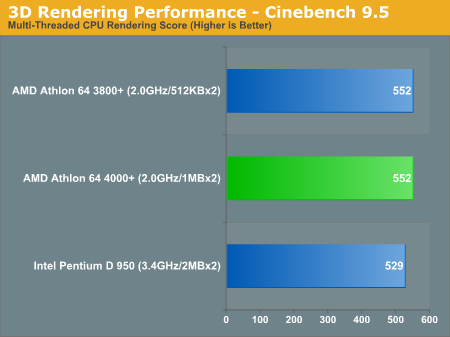
Cinebench 9.5 shows absolutely no performance difference between the 3800+ and the 4000+, indicating that the 512KB of L2 cache per core is sufficient for the dataset used in this test (alternatively it could be that even a 1MB L2 cache isn't big enough to hold the working dataset). The end result is that since the 3800+ and the 4000+ feature the same clock speed, in situations where a larger L2 cache isn't helpful we'll see absolutely no performance difference between the two processors. Combine this with the possibility that 512KB parts perform better on AM2 than they did on 939 and we start off seeing very little need to recommend the 4000+ over the cheaper 3800+.
3D Rendering - 3dsmax 7
Our next 3D rendering test has been around for a while on AnandTech, it's the 3dsmax 7 SPECapc test that we've used in past CPU reviews. The results we're reporting here are the SPECapc composite scores which are a geometric mean of four rendering tests and scaled against a set of reference scores that are included with the SPECapc benchmark package.

Once again we see basically no performance difference between the 3800+ and the 4000+, proving that clock speed is all that matters here with the Athlon 64 X2. Unlike the Cinebench test however, the Pentium D 950 is able to take the performance lead. Intel's Pentium D architecture continues to be quite competitive in 3D rendering and media encoding tasks as we're about to see.
Video Encoding - DivX 6.1.1 Pro
Next up to bat is DivX 6.1.1 Pro, once again a benchmark used in previous CPU reviews. Our testing methodologies haven't changed, so let's take a look at the results.
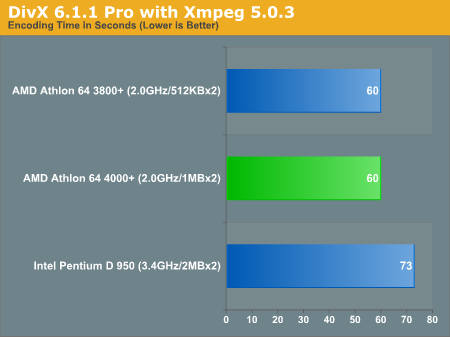
DivX performance is extremely strong with the Athlon 64 X2 4000+ and 3800+, but once again we see absolutely no performance difference between the two CPUs. Both AMD offerings are able to significantly outperform the Pentium D 950.
Video Encoding - Windows Media Encoder 9
While H.264 is the way of the future for video encoding, the vast majority of content today is still encoded in MPEG-2, DivX or using Microsoft's Windows Media Encoder codecs. Just as in previous reviews we're using the Advanced Profile enabled by installing Media Player 10 alongside WME9 which allows for better video quality options and as a result ends up stressing dual-core CPUs even more.
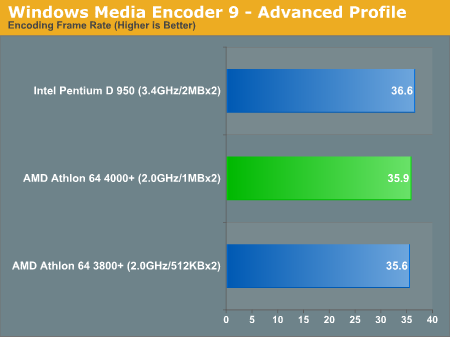
The Athlon 64 X2 4000+ manages to pull slightly ahead of the 3800+, but the two are basically tied. The Pentium D 950 is far more competitive in the WME9 test but isn't tangibly faster than the X2 4000+.
Video Encoding - Quicktime Pro 7.0.4 (H.264)
Until we get support for GPU accelerated H.264 encoding and/or faster CPUs, the number of H.264 encoding applications will remain quite limited. Apple's Quicktime Movie Trailers site has a great deal of H.264 encoded content and using Quicktime 7.0.4 you can generate the same quality, bitrate and file size of content. This is the same test we've run in the past, re-encoding the SD Quicktime movie trailer for Hoodwinked using the H.264 codec. All of the encoding settings were left at their defaults.
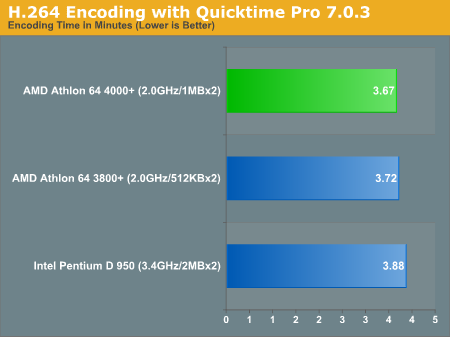
We continue to see a very small performance advantage for the Athlon 64 X2 4000+ but it's nothing worth writing home about, the X2 3800+ is just as good. The Pentium D 950 continues to be a close competitor but definitely isn't any faster than the two AMD solutions.
MP3 Encoding - iTunes 6.0.1.4
Almost a decade ago MP3 playback and encoding could bring even the fastest system to its knees, but today we can encode a 300MB wav into a 192 kbps MP3 in far less than a minute. We left all settings on their defaults except that we did not allow iTunes to play back the song while importing.
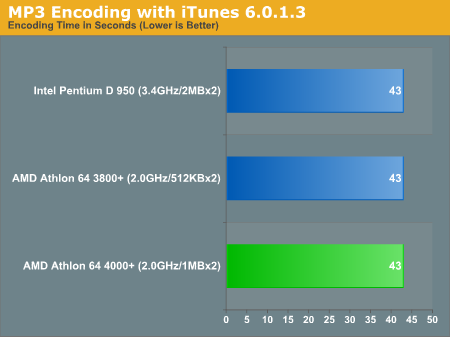
Given the nature of MP3 encoding it's not a surprise that there's no performance difference between the 4000+ and 3800+, but there's also no difference in performance between the AMD solutions and the Pentium D 950.
Gaming - Quake 4 1.1
With the later versions of Quake 4, id Software implemented multi-core support and we saw some pretty impressive performance gains on dual-core CPUs. As always we ran at the game's built in High Quality settings at a resolution of 1024 x 768; SMP was of course enabled.
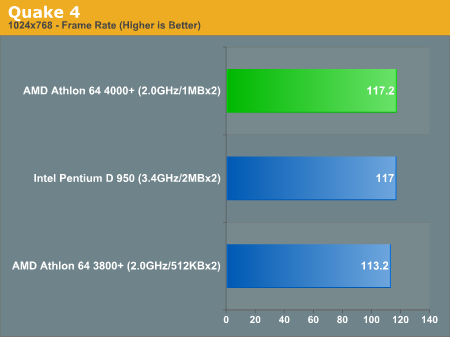
Just as we saw performance differences between AM2 and 939 in games, we see a difference between the 4000+ and 3800+ in these very same games. The fact that the AM2 platform sees a performance gain in 3D games indicates that they are noticeably more memory bandwidth dependent than other applications, and thus we see a benefit to the 4000+'s larger L2 cache. The Pentium D 950 does surprisingly well here, especially considering Intel's very poor reputation for gaming performance.
Gaming - F.E.A.R.
With the graphics options set to F.E.A.R.'s default High Quality and the computer settings at Maximum, we ran the built in F.E.A.R. benchmark reporting average frame rate.
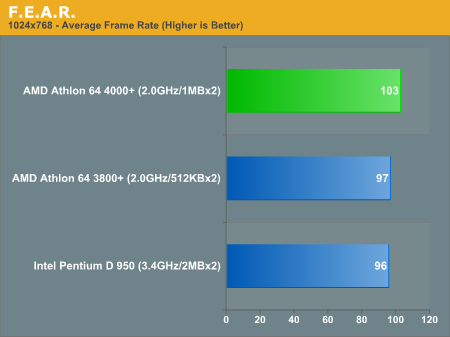
The Athlon 64 X2 4000+ holds a 6% performance advantage over the 3800+ thanks to its larger L2 cache, which continues to make a reasonable difference in our gaming tests. The Pentium D 950 is nipping at the heels of the 3800+, but the 4000+ is untouched at the top here.
Gaming - Oblivion
Our final gaming benchmark uses Oblivion at the same quality settings we used in our recent Oblivion CPU comparison, the only difference is that we ran at 1024 x 768 to make this more of a CPU test and less of a GPU test. We used our Oblivion Town benchmark and reported the average frame rate obtained using FRAPS.
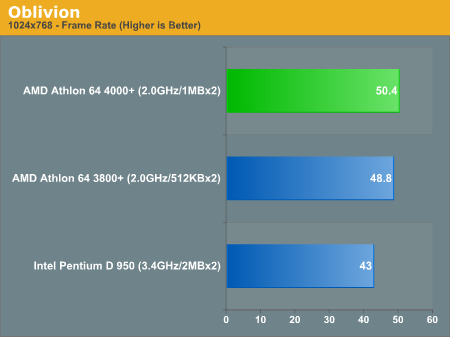
As we saw in our Oblivion CPU comparison, this game really favors AMD's K8 architecture for all of its strengths and severely penalizes the Pentium D for its NetBurst roots. The Athlon 64 X2 4000+ does continue to hold a performance advantage over the 3800+, but it isn't as large in Oblivion as we've seen in the previous two games.
So How Does the Athlon 64 X2 4000+ Stack Up?
At the end of the day the Athlon 64 X2 4000+ is still a very nice CPU that doesn't cost that much more than an X2 3800+; however, unless you're a gamer, you can probably get by pocketing the difference and sticking with the extremely competent 3800+. This is one of the unfortunate consequences of AMD's model number system, where a model number increase can be attributed to either a clock speed bump or an increase in cache size - the model number won't always convey true performance.
Surprisingly enough, the Pentium D 950 is extremely competitive here. Since it's built on Intel's new 65nm process the CPU is actually fairly cool compared to Pentium Ds of the past. Competition is good, but with sometimes significantly higher gaming performance, the Athlon 64 X2 still gets our recommendation here.










83 Comments
View All Comments
peternelson - Tuesday, May 23, 2006 - link
I see no benchmarking in 64 bit mode.
This is the future, and for maths, Intel's 64 bit was more of a lame copy of AMD 64 bit performance.
In future this will be increasingly important so even if 32 bit performances are comparable, I'd want to make sure the picture is the same running 64 bit apps.
Also you summarise "same performance, faster memory, less power". True, but you FORGET one of the main benefits: Pacifica Virtualisation.
True hardware virtualisation adds to the actual WORK you can keep that processor busy with. It saves time by letting you switch OS instances without rebooting timewasting.
As it is hardware based VT you should even be able to virtualise an UNMODIFIED OS like Win XP, maybe even Vista!
So please play with Xen3.
As you say virtualisation "works" then it is a BIG factor for me in choosing AM2 over 939, (all other things being equal).
Also the fastest 939 chips have been produced, and AM2 is reaching higher models now.
So if you want the VERY fastest, it is only available on AM2.
Don't forget: Not just performance, but performance PER WATT. For these AM2 chips that is similar to 939.
However, the announcement of 65W EE and EVEN 35W SFF EE!!! are significant compared to the standard 89W
Intel seem to be positioning Conroe as being "33% better" on performance per watt. However, Conroe isn't even here but when it is, it may not be able to compete with AMD low power offerings.
Also consider the whole system for conroe vs AMD. Because that AMD power INCLUDES the memory controller, whereas Intel doesn't. The whole motherboard etc may use less power.
Also in terms of entire system cost, motherboards for AM2 appear to be a bit cheaper than their Intel equivalents, which may offset the current high prices of AMD processors.
fitten - Wednesday, May 24, 2006 - link
You should check out the Woodcrest (server targeted Conroe core) previews for power measurements. Performance per Watt, Woodcrest wins (and will be available in 3 weeks)... Absolute power usage under load, Woodcrest wins... and note that the power measurements are for the complete system (video card and HDDs included). (Deep power conservation couldn't be tested on Woodcrest because the parts didn't have it enabled as they were engineering samples.)Also, check out the 64bit vs. 32bit comparisons in programs like Cinebench 9.5. Seems Woodcrest 64bit gives a nice boost there (showing that it isn't just a 'lame copy').
You also seem to forget that Intel already has virtualization extensions out in currently shipping processors (much less Conroe+).
As far as price, there have been price lists published already. High end Conroe parts are already listed for 1/2 the price of the high end AMD parts... at $500 that gives another $500 for purchase of a motherboard before it touches just the CPU cost of the AMD... I doubt that the motherboards will be that expensive.
I have 7 AMD machines (four are Athlon64s or X2s) but right now, it looks like my next machine will be a Core2 one. AMD needs to get an answer out... soon. K8L isn't going to cut it. Sure, it'll be good at FPU but the vast majority of work done by CPUs is integer, which are what the majority of improvements are in Core2 (not that they don't have good FPU improvements). So, if you're in a government lab running FPU intensive simulations, K8L may be for you. If you're anyone else, K8L as it has been described looks kind of anemic and not a match for Core2.
Maybe the real K8L will surprise us, who knows, but it is at least 6 months away (if not longer). By that time, Intel will already be 25% into it's 2-year cycle for the next Core derivative chip (probably farther, time between releases is set to 2-years). AMD looks to be in a bad situation right now... If they have something they're keeping secret, IMO, they need to at least tease us with it. K8L is not a tease, it's only slightly more than a stifled yawn. The longer they go without giving us something to look forward to, the more it looks like they are in major trouble.
Accord99 - Wednesday, May 24, 2006 - link
[quote]Don't forget: Not just performance, but performance PER WATT. For these AM2 chips that is similar to 939.However, the announcement of 65W EE and EVEN 35W SFF EE!!! are significant compared to the standard 89W
Intel seem to be positioning Conroe as being "33% better" on performance per watt. However, Conroe isn't even here but when it is, it may not be able to compete with AMD low power offerings. [/quote]
Given that Woodcrest 3.0GHz has a TDP of 65W, which is borne out by power measurements conducted by Techreport and 2CPU, it's likely that a Conroe that matches the performance of the 35W X2 will at the very least, also match it in power.
soydios - Tuesday, May 23, 2006 - link
AMD motherboards are less expensive because they don't have to put in a memory controller.AMD processors are more expensive for 2 reasons:
- integrated memory controller takes up more die space (offset by cheaper motherboard)
- AMD is still using 90nm on 200mm wafers, while Intel is using 65nm on 300mm wafers (Intel gets more CPUs per wafer bigtime)
peternelson - Tuesday, May 23, 2006 - link
Sempron AM2 can do memory up to DDR2-667
Dualcore AM2 can do memory up to DDR2-800
However, PLEASE CHECK SINGLE CORE MEMORY SPEED (multiplier issues aside) which you say limited to 667 whereas I got the impression they can also do 800 like dualcores. Correct as necessary.
smitty3268 - Tuesday, May 23, 2006 - link
I accidentally hit the "not worth reading" button, so I'm writing this comment to undo it :)fikimiki - Tuesday, May 23, 2006 - link
There are a couple of reasons for that:- K8L photo had a Z-RAM implemented, so they are using this kind of cache for a quite long time.
- Shared L3 should help Athlon64 in matching Super-Pi and overall performance.
- Usage of Z-RAM will reduce cache die size by 75% with no architectural changes.
So FX-64 to beat fastest Core 2 just needs 4MB of cache...
Easy trick but can be useful to survive till 65nm production...
Questar - Tuesday, May 23, 2006 - link
It's not going to be Z-RAM. Z-RAM won't even be in K8L.
“We’ve looked at data from Innovative Silicon and it looks very promising. We still need to assure ourselves that this will work in our own application. We need to see how it scales and we need to make our own test vehicles,”
Jones, an executive experienced in intellectual property licensing, also declined to comment on AMD’s timetable for introduction of Z-RAM but offered a more general perspective. “In the past it has been two years from when you sign a deal to when it is in production.”
http://www.eetimes.com/news/latest/showArticle.jht...">http://www.eetimes.com/news/latest/showArticle.jht...
munky - Tuesday, May 23, 2006 - link
I think the June trick AMD will pull out is the Clearspeed coprocessor. It definitely won't affect many users, but for those who do invest in the technology, it could provide a decent boost in number crunching power.peternelson - Tuesday, May 23, 2006 - link
Clearspeed are working on being one acceleration solution, yes, but the already launched acceleration on socket 940 is companies offering plug in Xilinx4 FPGA on hypertransport.
I hope that gets re-engineered onto socket F pretty quickly. We may see announcements once socket F is actually launched in July.